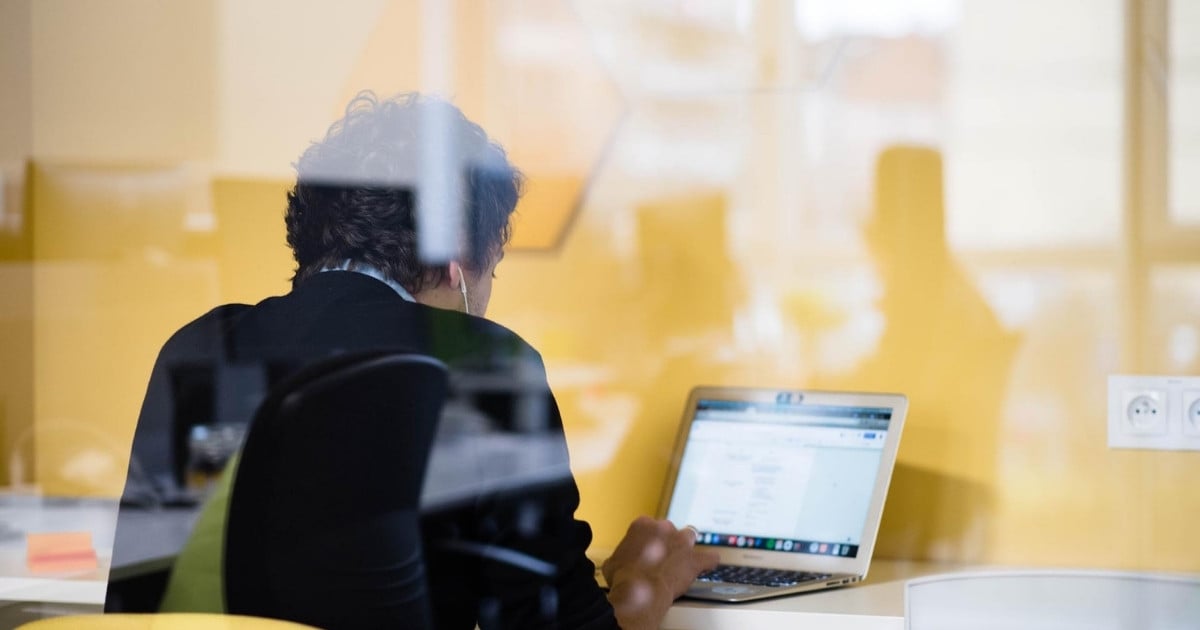The Only UX Design Process Guide You Will Ever Need
Do you have a UX strategy in place? To make sure you put users and their journey first, it is essential that you prioritize the UX design process in your product development cycle.
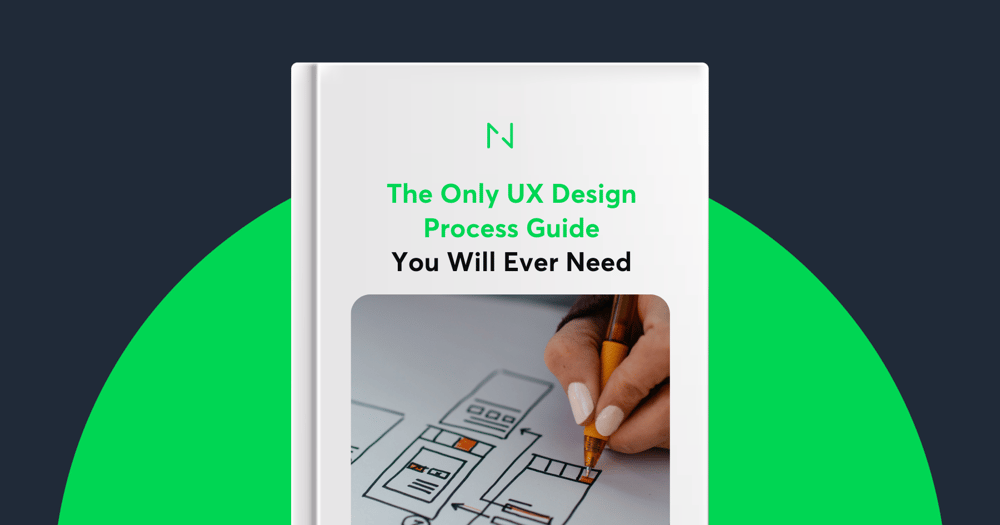
Introduction
Contents
Effective user experience design creates a streamlined and interactive journey. It covers everything from divergent and convergent thinking to user research and prototyping. There are several approaches to consider – from Double Diamond to Design Sprint, each with its own focus and methods.
At Netguru, we’ve developed our own design process, using well-known models as a base. In this article, apart from giving you some definitions, history, and pro tips, we’ll outline our unparalleled design process for UX.
This UX Design Process Guide has been prepared by Mateusz Kłosiński, Senior UX Designer at Netguru.
What is the UX design process?
A design process comprises the steps you must take to convert an idea to reality. How about adding user experience into the mix? Focusing on the user has roots in the ancient science of ergonomics, but the term wasn’t formally coined until 1993 when Don Norman, a cognitive psychologist and designer, joined Apple as a User Experience Architect. Interestingly, it was the first time “User Experience” was seen in a job title.
Speaking in an interview, Don Norman said: “I invented the term because I thought human interface and usability were too narrow. I wanted to cover all aspects of the person’s experience with the system including industrial design graphics, the interface, the physical interaction, and the manual.”
The UX design process spans the steps you need to create a product or solve a problem while keeping the user’s experience and goals in mind. The target? A UX that’s satisfying, meaningful, and pleasant.
What are the goals of the UX design process?
Ultimately, without a clear and strong UX design process, your product has less chance of offering people a fulfilling experience. A well-defined and executed process shapes and guides designers’ work and helps them build intuitive and streamlined experiences for users.
A robust UX design process:
- Establishes clear expectations. When you share your UX design process with the client, you can work together to set deliverables and deadlines, where each party knows what they expect of each other.
- Puts your clients’ mind at ease. By laying out a clear UX process, clients are aware ofhow the design team works. They can monitor what’s happening at every design phase and see how their idea translates into a quality final product and experience.
- Reduces risk of failure. A well-thought-out UX process takes a rounded and researched approach, looking not just at visual aspects but also factors like usability, which increases the chances that the product will be a success.
Cooperation between you and your client
The best design isn’t always the first one you think of. Moreover, you can’t know what the ideal design is until you generate more than one solution and compare them. With that in mind, design is an iterative process and often involves assessing several ideas. It is good to set up creative sessions where designers and stakeholders are challenging the ideas to find the best solution. Through that, you highlight:
- There’s more than one design solution or direction to take.
- You’ve taken time, effort, and imagination to think things through.
- You understand the client’s needs.
- Your clients have a choice, which helps them feel involved and part of the process.
As a result, you earn their trust and strengthen the client-partner relationship.
A successful UX design process is customized to the client and their individual requirements. There’s no room for pre-built templates – these only serve to lower the client’s opinion of the design team. Bespoke and long-term plans build client confidence and demonstrate the design team’s skill and breadth of knowledge. Your UX design process must stand out from the crowd, so evaluating and determining the best way forward is key. This, in turn, adds value to not just the project but also your connection with the client.
Five-step UX design process
There are several process models that designers can choose from. We’ll describe a few of them later on, but at this juncture, it’s important to underline that even though you can follow different models, the flow beneath each of them is similar and usually adheres to divergent and convergent thinking.
What do we mean by divergent and convergent thinking?
Divergent and convergent thinking makes up the basis of the UX design process. Both of these ways to approach problems and solutions are essential, acting as counterbalances:
- Divergent. It’s all about broad, free-flowing, non-linear thinking, having an open mind, and considering multiple angles and perspectives.
- Convergent. The opposite applies here, which means your thoughts are narrow, linear, and focused. You identify one or two core problems and solutions as well as scope down a project to what’s possible and deliverable.
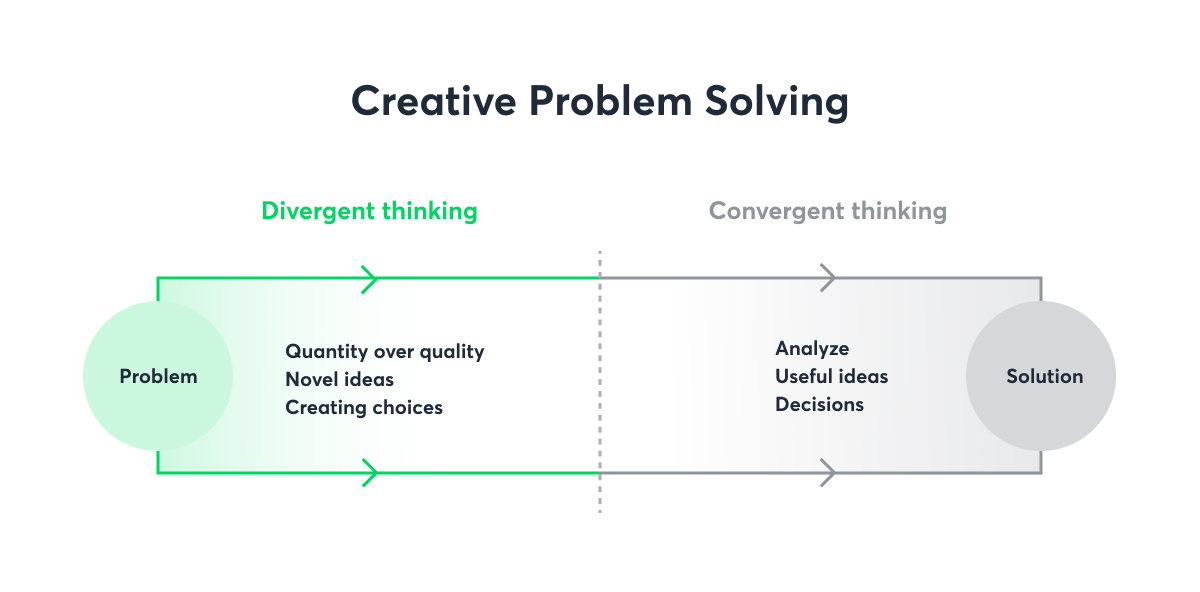
Divergent and convergent thinking aren’t mutually exclusive, meaning you gather a diverse and extensive set of information and then reduce and refine that.
UX product design process uses divergent and convergent thinking and most often consists of five steps. Before delving into specific models, let’s look into them one by one.
1. Product definition
Before the product team actually builds anything, there has to be context surrounding why it's being created in the first place. The product definition phase lays those foundations, whereby UX designers brainstorm with stakeholders at a concept level, gathering insights about their business goals.
Alongside that, there’s usually value proposition mapping. Here, key aspects of the product are discussed, including what it is, who will use it, why they will use it, and what makes it attractive to customers. By doing that, the team and stakeholders reach a consensus on what the product will be, as well as how to match user and business needs. This phase will feature concept sketching during which designers will develop an initial mockup of the product.
This stage will also involve a kick-off meeting, where the key players come together to set project expectations for both sides: the product team and stakeholders. The meeting covers a high-level outline of areas such as:
- Product purpose
- Team structure – who will design and develop the product
- Communication channels
- Stakeholder expectations, such as KPIs and success metrics
2. Research
Once the definition is complete, it’s time to move on to the research phase of the UX design process, including both market research and user research. While it is undoubtedly a valuable investment, it informs design decisions – and if done early (always advisable), it saves money down the line.
This phase varies from project to project, depending on various factors, such as complexity, availability of resources and timing, but generally, it includes individual in-depth user interviews (IDI) and competitive research. The former phase involves talking to potential users from your target audiences to collate qualitative data about user behavior, needs, wants, fears, and motivations. The latter phase is all about helping UX designers understand industry standards and identify the ways the product can stand out.
3. Analysis
At this point, you draw insights from the data you collected during the previous stage, establishing the “why”. Why do potential users want what they want, think the way they do, and need the things they’ve outlined? This is when designers confirm whether the previously made assumptions are correct, and may include:
- Building user personas. These are fictional “characters” or realistic representations of different user types within your target audience. They’re built around factors such as gender identity, age, occupation, frustrations, motivations, personality type, preferred brands, and communication channels of choice.
- Developing user stories. These are tools that help UX designers comprehend interactions with a product or service from an end user’s perspective. For instance, “As a [user], I want to [goal], so that [motivation].” An example of a goal is living more sustainably; motivations range from fear to power.
- Storyboarding. This tool creates a picture of how a user interacts with your product, helping designers connect user personas with user stories.
4. Design
This is when users’ wants, needs, and expectations are set out. It’s time to move to the design phase and areas such as user flow and site maps. During this collaborative and iterative stage, activities such as creating information architecture (IA) and UI design are worked on and validated. There’s also:
- Sketching: A quick and easy way to visualize a diverse range of ideas during brainstorming. This method involves drawing by hand using paper, a whiteboard, or a digital platform.
- Wireframing: Another visualization method that helps designers envisage the basic structure and visual hierarchy of a page interface, such as key elements and how they fit together. The indispensable activity involves designers using wireframes as the basis for mockups and prototypes.
- Prototyping: Focuses on the actual interaction experience and acts as a simulation of the product.
- Design specification: By creating it, you inform developers of the visual design assets that are needed to turn prototypes into a working version of the product.
- Design systems: Once you’ve developed a scheme of components, patterns, and styles – designers and developers are on the same wavelength in terms of the final design.
5. Validation
Aka testing, this essential final step of the UX design process involves a series of user testing sessions with users who represent your target audience. The phase helps teams understand whether the design actually works for both potential customers and stakeholders. Types of user testing include usability testing, A/B tests, as well as focus groups.
Additional actions that take place during this stage involve testing in-house to discover usability flaws and feedback surveys for gathering quantitative and qualitative data from real-world users. You can start validating the product at an early stage by testing a clickable prototype, or later, using metrics once the product is live. Analytics on areas such as clicks, navigation time, and search queries will reveal how users interact with the product.
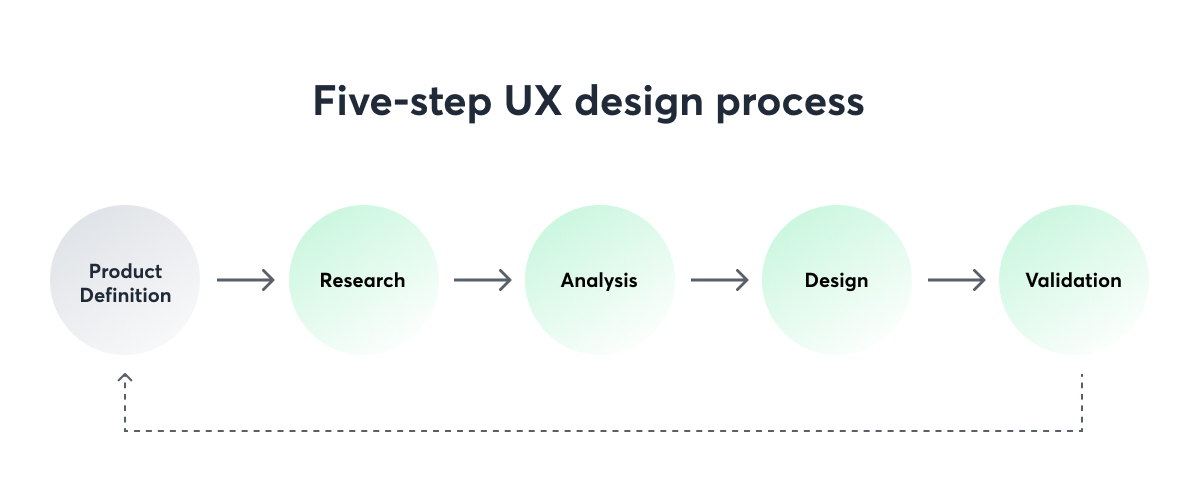
Popular design processes
A tried and tested UX design process achieves results – but which one is best for your project? There are several well-known blueprints to choose from, encapsulating the above steps. Below, we’ll look into three of them.
Double Diamond
A high-level strategy using divergent and convergent thinking – the world-renowned Double Diamond approach was developed by the British Design Council in 2004 and is described by them as “a clear, comprehensive, and visual description of the design process.”
The framework is generally used for a long-running process and whenever broad brainstorming is required. Usually managed by a single designer or team, this method helps you define milestones and highlights what you should focus on at each stage.
The ethos? Ideas should go through divergent thinking before being refined through convergent thinking. Think about divergent thinking as opening your arms wide to catch all the creative ideas and going narrow to draw out the main essence.
As part of that, Double Diamond is divided into four key phases:
- Discover. Use divergent thinking to understand the problem you’re trying to solve by collecting the information and talking to people affected by the issue.
- Define. Use convergent thinking and insights from the discovery stage to frame the fundamental challenge, identify the right problem, user personas, and create a clear brief.
- Develop. Employ divergent thinking to start establishing your solution – keep your user personas in mind and create a proof of concept where you test ideas.
- Deliver. Convergent thinking comes back into play when you build the solution to the problem and gather market feedback.
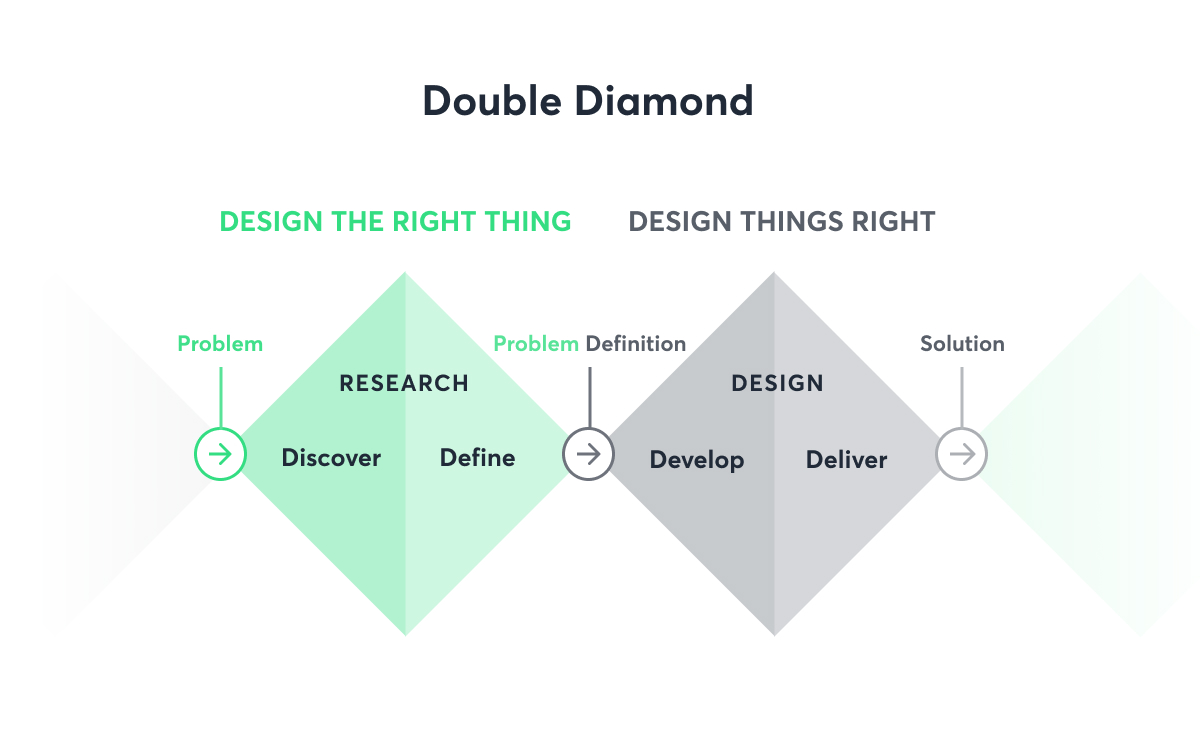
Exploring ideas and executing the “best” ones should focus on putting people first, communicating visually and inclusively, collaborating, co-creating, and iterating.
Challenges associated with this model include little emphasis placed on time, which means that the project manager is responsible for creating a timeline. Also, some describe the framework as too linear, meaning it doesn’t necessarily align with today’s Agile approach.
Our pro tips for this approach include:
- Always start with research.
- At each step, carry out as many exercises as possible and invite your team to participate. The more creative minds are involved, the better.
- It’s an iterative process, not a linear one, so don’t worry if you repeat some steps – you’ll always have new ideas and findings.
- Track your design decisions via documentation to keep on top of what you’ve done, as well as when and why you’ve done it.
- Store materials from your creative sessions in one place – for example, a shared drive or a Miro board.
Design Thinking
This model was popularized by IDEO and d.school and has been going strong since 2005. Think of it as a toolbox of methods you can use according to the needs of the project. It involves many creative processes that are focused on speedy problem-solving. It comes down to validating concepts with prototypes at the early stages of product development.
“Design thinking is a human-centered approach to innovation that draws from the designer’s toolkit to integrate the needs of people, the possibilities of technology, and the requirements for business success,” says Tim Brown, Executive Chair of IDEO.
The non-linear, iterative framework is divided into five phases:
- Empathize. Gain an empathetic understanding of the problem by setting aside your own assumptions and researching users’ needs to get real insights.
- Define. Collate that data and analyze observations to define problem statements and create user personas.
- Ideate. Brainstorm and challenge assumptions to look for alternative ways to view the problem and identify innovative solutions.
- Prototype. Determine the possible solution for each problem by creating prototypes (scaled-down versions of the product) to investigate your ideas.
- Test. Rigorously test your prototypes, returning to previous steps to make changes and refinements if necessary.
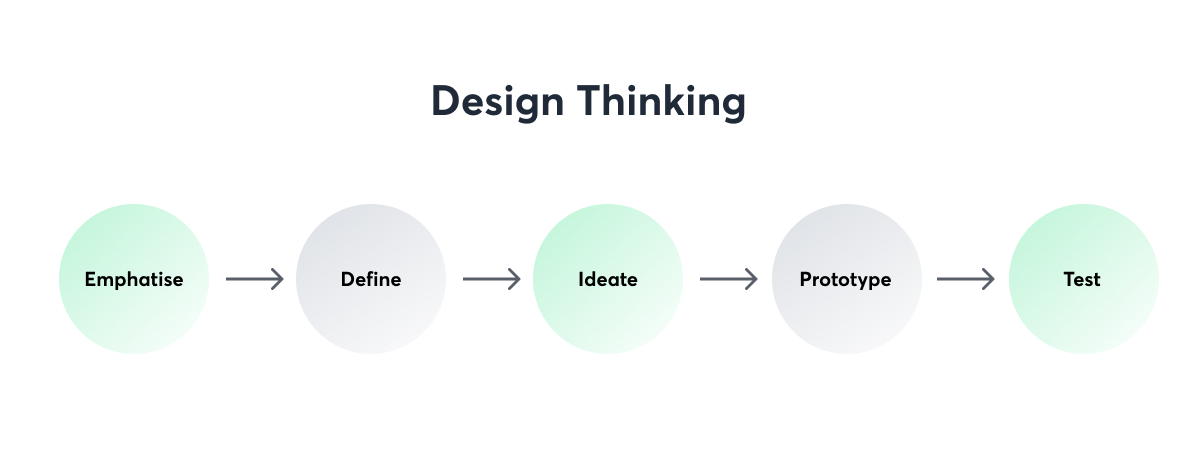
Following that, it’s all about implementing and launching.
This approach works well when you’re trying to understand or solve open-ended problems in a specific area of expertise. However, it’s less useful when the outcome is mostly known in advance.
It’s important to mention that Double Diamond and Design Thinking are sometimes confused and merged because they both allow the design team to go from a problem to a solution via similar phases. The main difference is that Double Diamond is seen as a higher perspective of the design process itself, setting the steps the designer or design team should follow.
Here are some of our top tips for Design Thinking:
- Spend enough time creating the correct problem statement – challenge your assumptions to make sure you’re solving the right issue.
- Design thinking is strongly focused on teamwork – if you want to follow this model, invite people from different disciplines to widen the perspective.
- The process is usually carried out as a set of workshops that can take one to two working days, depending on the problem you’re trying to solve.
- Put the user at the center by getting to know them along with their needs – design thinking is all about delivering optimal value.
- There’s no better way to figure out the best products than testing and iterating at every stage of the design. Sometimes, a drawing might be enough to validate an idea.
- Iterate, iterate, iterate. Repeat previous steps in a different order as much as you need to achieve an outcome your target users will love.
Design Sprint
Created by Google, a Design Sprint is their version of the Design Thinking model. It takes up to five days and is the most structured of the models we talk about. It’s a short, simple, and focused way of bringing a team together, as well as understanding a problem and solving it.
The model takes influences from the Agile development approach and is tailored to digital products. The main steps are:
- Understand. Create a shared knowledge base using the Lightning Talk method, define the project scope, and map the user journey.
- Define. Evaluate phase one findings, outline context and desired outcomes of potential solutions, as well as choose a specific focus, goals, and metrics.
- Sketch. Share a diverse range of ideas and alternative solutions individually, then narrow these down to a single Solution Sketch per person.
- Decide. Share the Solution Sketches, then finalize the direction and design concept by deciding on a single idea.
- Prototype. Create a prototype facade – no need to build a fully functioning backend.
- Validate and test. Put your prototype in front of people, gather user feedback, and end the stage with a validated concept or an invalidated one to improve on.
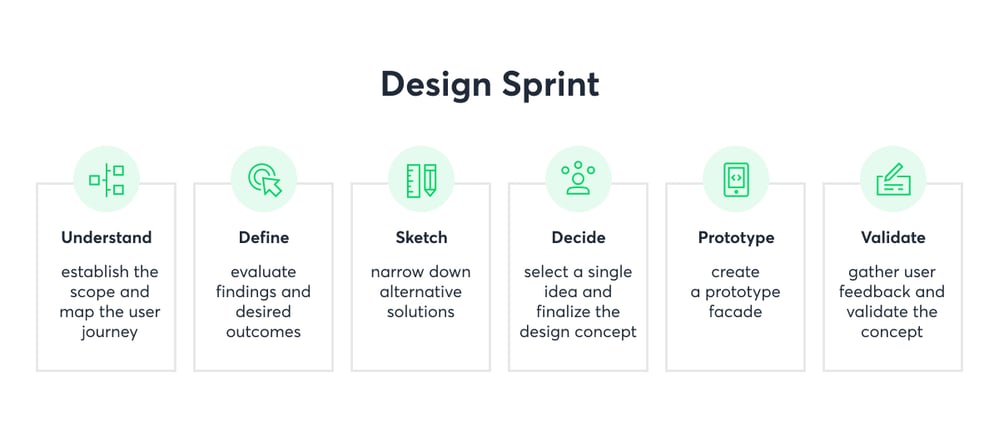
According to Google, you should use Design Sprints at the start of a new project to create a vision and define a product. They’re also useful when you need to work quickly, if you’re blocked on an issue, or if you need to take action after uncovering new insights.
Meanwhile, don't use them if you don’t have a robust understanding of your target users, if you already have a clear direction but just need time to design, or if you haven’t obtained buy-in from leadership.
The handy tips in this case would be to:
- Write down all the information, as you never know what will become helpful at a later stage.
- Mind the time, as it’s limited and thus needs to be used well.
- Trust the approach. Design Sprints help you create amazing products, so focus on facilitation instead of inventing the process from scratch.
- Focus on “what” (the problem) and “who” instead of “how”.
- Make sure all participants stay committed and don’t leave the workshops – everyone’s an integral part of the process.
- Don’t allow people to get distracted by phones or computers.
- Make sure everyone is familiar with each step before starting.
- Include research to get immediate user feedback. Organize people in advance, since you already know when user testing will happen.
- Don’t expect to get the final, polished result at the end of the Design Sprint – it’s a starting point. For example, while it’s unlikely you’ll end up with a fully working app, you’ll probably have a concept and a list of features.
- Enjoy it! The more fun you have during the Design Sprint, the more creative and out-of-the-box ideas you’ll deliver. As part of that, make sure everyone feels secure and that you welcome each idea.
Netguru’s process
Here at Netguru, to achieve exceptional UX design, our UX professionals focus on a human-centered approach. Our UX services help us create intuitive experiencesthat are tailored to the customers, including:
- Designing web and mobile apps
- Understanding your users
- Validating your ideas
- Improving conversions
- Streamlining the user experience
- Building responsive products
- Ensuring that the content is relevant
- Refining your website structure
Design process
Our dedicated UX product design team helps clients craft an idea for a new product or elevate the quality of an existing solution. Our process focuses on delivering a product that’s laser-targeted to the users’ needs through:
- Project setup: Ensuring our team has the core info and assets.
- Research & concept: Gathering insights and shaping the product and/or features.
- Wireframing: Transferring ideas into connected wireflows.
- Testing & validation: Authenticating design solutions with typical users.
From there, the user interface (UI) design kicks in with:
- Visual design: Creating intuitive, beautiful interfaces that align with our insights.
- Development handover: Getting ready to implement our designs into working products or services.
Netguru case studies
We’ve spent years honing our processes and incorporating industry best practices. To that end, we’re ready with proven tools and battle-tested methodologies that consistently deliver first-rate products and services. Read on for just a few examples of our work.
Shine
This award-winning self-care mobile app helps users deal with daily stress via well-being content. We partnered with Shine on UX and UI design. Thanks to its excellent usability, the app has gained worldwide acknowledgment with 7,000 5-star reviews.
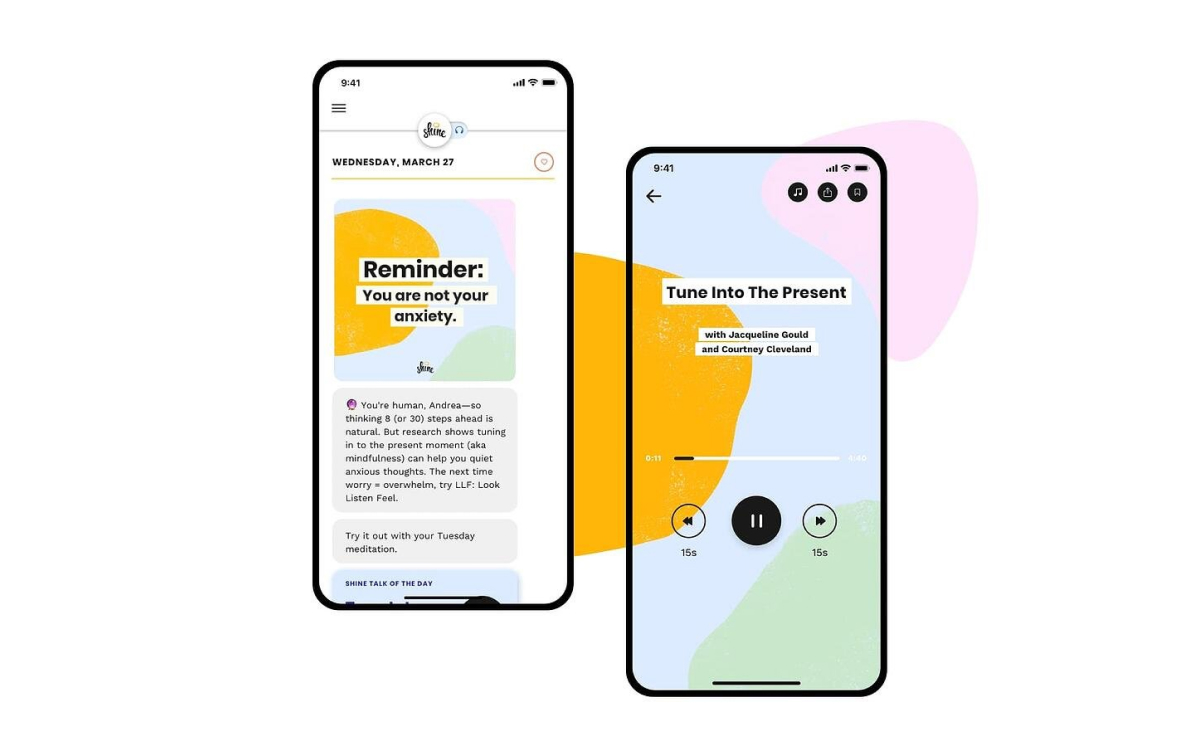
Babbel
This time, we helped the leading language learning platform build a new business branch. As part of that, we created an additional module for the existing app to prepare it for a new B2B strategy, empowering administrators to manage users with greater flexibility. The new module had to fit with the brand’s existing image, so we worked on the dashboard flow, making the user journey smooth and intuitive for customers.
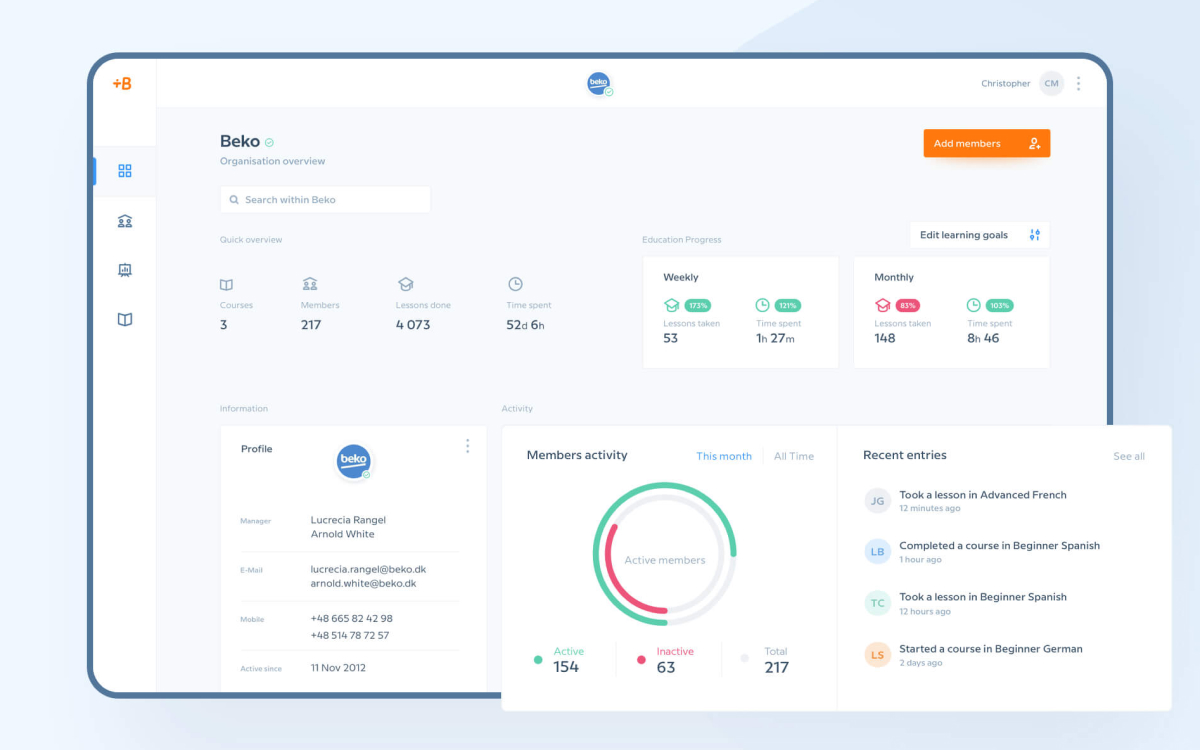
Design Sprint
Speaking of the UX design process, we should mention that Product Design Sprint is our workshop approach that combines best practices from Design Thinking and Design Sprint, allowing us to explore new products and ideas together with different perspectives. It helps us identify the right way forward without risking large sums of money. We believe it’s best to start a project with a Product Design Sprint and continue its development using our UX design process services.
Design Sprint
There are inherent risks to launching a new product or feature, let alone doing that successfully. Our Product Design Sprint is a five-day workshop that uses Design Thinking to help mitigate those risks, where each day corresponds to a problem-solving stage.
This planning methodology gets you answers to critical business questions fast and helps you solve complex business issues. The five phases enable you to better understand your business ideas and needs. Our workflow has proven effective in finding the right solutions for various clients, such as Volkswagen and The City of Warsaw.
We’ve found a powerful way to explore varying perspectives and identify the optimal direction to take, and it goes as follows:
- Understand. The first day involves gathering insights and a full understanding of user requirements, needs, and technology capabilities. Discussion and brainstorming are vital, helping us create a roadmap for the sprint week ahead. We establish long-term goals, highlight obstacles and challenges, run big-picture exercises, and finally pick the main goal to achieve. That target is ambitious but manageable and solvable within a week. To inform our decision-making, we use tools like stakeholder mapping and user personas.
- Diverge. Day two is all about generating and exploring as many ideas as possible. We’ll review the pros and cons of existing solutions, while the participants will develop new insights and solutions. Via brainstorming sessions, alongside individual analyses, sprint members are coming up with ideas to be studied and tested later in the week. Customer journey mapping helps us gain a deeper understanding of how users interact with a product and identify user pain points.
- Converge. By this stage, we’ll have produced plenty of ideas, but they can’t all go forward for testing. Now is the time to decide the best solutions to prototype in the following phase. How? By critiquing each solution in relation to the main goal. Once selected, we create a storyboard and sketch a step-by-step prototype roadmap.
- Prototype. Day four is the time for putting chosen ideas into practice by turning storyboards into a prototype – a realistic but low-fi first version of the product you can then test with potential users. By building only the customer-facing surface, you don’t waste time and can still get valuable user feedback. Prototypes should be up and running in one day and can be paper-based (cheap and quick) or digital (more interactive and realistic).
- Test. The final day is about testing your ideas with users, business stakeholders, and technical experts, as well as getting direct feedback. You gain valuable insights by interviewing users and watching them use the prototype. The idea is to validate your solution before you invest in design and development. At the end of day five, you’ll have a clear idea of the road ahead and whether you need to make changes or refinements before proceeding.
After the Product Design Sprint, our team sends you a detailed digitized report from the workshops, including:
- Lo-fi prototypes
- Project roadmap in phases
- Pre-defined tasks for each stage
- User journey maps and storyboards
- Information architecture diagrams
What are the benefits of Netguru’s Product Design Sprints? You end up with solutions and recommendations, which enables you to develop a unique value proposition.
Implementing the UX design process from scratch
Let’s take a look at design process tips that will help you navigate product development and achieve desired results.
- Define your goals in an overarching discovery statement before you begin the UX design process. Goals support creative thinking, give your project purpose, and help you identify potential issues. Questions to ask include:
- What’s your ultimate goal?
- What are your business goals?
- Are global issues impacting you, and if so how?
- What currently works and what doesn’t?
- What’s your strategic direction?
- Gather the right team with a diverse set of perspectives, approaches, and expertise with at least one person from each area of the company.
- Choose the design process you want to follow (or define it with your team) and get to know it well before starting the project.
- Plan your design phases and stick to deadlines. The more you use the process, the easier it will be for you to plan the steps. However, remember you may revisit phases and that’s okay.
- Structure the UX design process in steps that naturally follow one another and make sure everyone in your team is familiar with the approach.
- Plan enough time for each step. Don’t shorten or skip stages because the process won’t be complete and you may have to revert back.
- Always start with research. Don’t overestimate how well you know your users – you’ll always discover something you didn’t expect. Listen, ask questions, collaborate, and remain unbiased.
- When identifying your problem, use knowledge collected from the UX research phase. Generally, a few key problems will emerge. Once that happens, keep focused on the problem(s) you’re trying to solve along with the end goal.
- When ideating your solution, be creative. Start with brainstorming sessions using sticky notes, lego blocks, toys, etc. Visualization techniques also help, and they encourage inclusivity. Consider people’s individual styles and preferences in terms of how they communicate best. Don’t begin by drawing beautiful high-fidelity designs. It's better to draw fast and simple using pen and paper than a design tool like Figma. Using such a tool won’t broaden your imagination and will make you follow the already known rules. In short, think out of the box.
- Prototype your ideas iteratively. Work quickly here, and remember it’s okay to fail and eliminate ideas that aren’t working. Don’t get too stuck on one idea or prototype. There are lots of amazing UX design tools for fast prototyping, including Figma, Sketch, and Framer.
- Test your ideas and prototypes with potential customers and colleagues as much as possible – it’s not necessary to wait until you have a final version of your low-fidelity prototypes. Ask for feedback and ways to improve, then iterate.
- Keep the right mindset throughout. Make sure everyone knows what the goal is and how you’re going to achieve it. Encourage people to listen, collaborate, and maintain a positive attitude. Don’t forget to take notes and record the sessions.
- Accept changes. The UX design process is agile and flexible, and it may alter based on the project, time, and other factors. At some point, your team may develop their own design process, which is great, as long as it serves its purpose.
Improving a pre-existing UX design process
Let’s face it, most of us have long-standing processes that we do because it’s the way things have always been done. It’s time to shake things up and make existing methods better and more efficient. Here’s how:
- UX designs rarely come from one person alone, so make sure you have a strong team with different skill sets.
- Build a shared vision of the product that’s understood by everyone in the team. To do that, create a clear strategy, where each person is aware of their role and what value they bring.
- Support collaborative work throughout the entire process so that different perspectives are considered and varying needs are understood. Products are often created by people from multiple areas, such as design and development teams. To that end, good communication is a key UX design skill.
- Encourage your team to collaborate using tools like Miro, Figma, and Google Docs to ensure smooth workflow.
- Consider implementing Lean UX methodology in your Agile approach – a quick and simple way to question and prove a hypothesis without wasting time building a real solution.
- As part of that, test hypotheses and prototypes with real users and ask for feedback. That way, you understand whether or not your product and design meet expectations.
- Emphasize user research as a natural part of your UX design process. UX teams are aware of the benefits of user research, but it’s not always integrated into the UX design process.
- Introduce a culture of constant feedback – encourage your team to constructively evaluate each other's ideas and designs.
- Organize retro sessions where the team can share their thoughts and opinions about the project and design process – and make use of the feedback generated from these discussions.
UX design process: the lowdown
Research by PwC revealed that 82% of top-performing companies pay close attention to user experience. It can’t be denied that developing and following a clear UX design process is a key part of that. Whether you opt for a pre-existing model, such as Design Thinking or Double Diamond, or create your own model, five core focus areas are likely to be incorporated: definition, research, analysis, design, and validation.
Outstanding UX design is about building human-centered products that engage users. The well-established design process for UX helps you build forward-thinking yet easy-to-navigate user experiences that are tailored to your customers. With the UX design process, it is possible to simplify your work and provide a flexible way to create products.
It is important to build a strong partnership between you and the UX Design Agency and find a partner to support you in achieving business results.
Mateusz Kłosiński
Mateusz brings over 5 years of experience to the table in User Experience design His talents range from leading research initiatives, organizing workshops and creating stunning designs for web, mobile and desktop applications.




